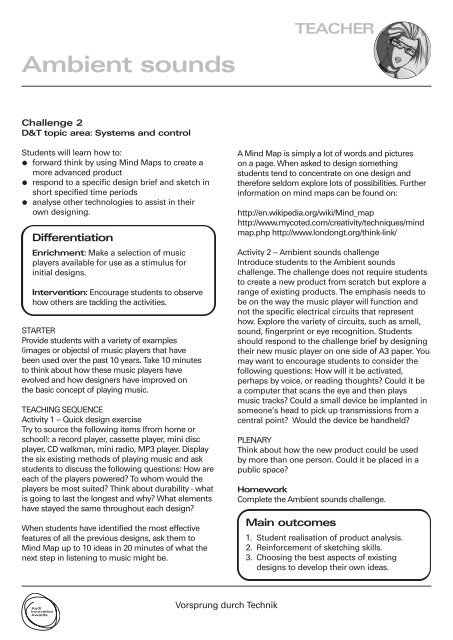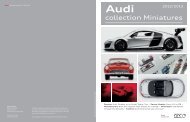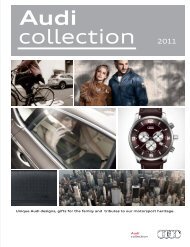The perfect Plecticle - Audi
The perfect Plecticle - Audi
The perfect Plecticle - Audi
Create successful ePaper yourself
Turn your PDF publications into a flip-book with our unique Google optimized e-Paper software.
Ambient sounds<br />
Challenge 2<br />
D&T topic area: Systems and control<br />
Students will learn how to:<br />
forward think by using Mind Maps to create a<br />
more advanced product<br />
respond to a specific design brief and sketch in<br />
short specified time periods<br />
analyse other technologies to assist in their<br />
own designing.<br />
Differentiation<br />
Enrichment: Make a selection of music<br />
players available for use as a stimulus for<br />
initial designs.<br />
Intervention: Encourage students to observe<br />
how others are tackling the activities.<br />
STARTER<br />
Provide students with a variety of examples<br />
(images or objects) of music players that have<br />
been used over the past 10 years. Take 10 minutes<br />
to think about how these music players have<br />
evolved and how designers have improved on<br />
the basic concept of playing music.<br />
TEACHING SEQUENCE<br />
Activity 1 – Quick design exercise<br />
Try to source the following items (from home or<br />
school): a record player, cassette player, mini disc<br />
player, CD walkman, mini radio, MP3 player. Display<br />
the six existing methods of playing music and ask<br />
students to discuss the following questions: How are<br />
each of the players powered? To whom would the<br />
players be most suited? Think about durability - what<br />
is going to last the longest and why? What elements<br />
have stayed the same throughout each design?<br />
When students have identified the most effective<br />
features of all the previous designs, ask them to<br />
Mind Map up to 10 ideas in 20 minutes of what the<br />
next step in listening to music might be.<br />
Vorsprung durch Technik<br />
TEACHER<br />
A Mind Map is simply a lot of words and pictures<br />
on a page. When asked to design something<br />
students tend to concentrate on one design and<br />
therefore seldom explore lots of possibilities. Further<br />
information on mind maps can be found on:<br />
http://en.wikipedia.org/wiki/Mind_map<br />
http://www.mycoted.com/creativity/techniques/mind<br />
map.php http://www.londongt.org/think-link/<br />
Activity 2 – Ambient sounds challenge<br />
Introduce students to the Ambient sounds<br />
challenge. <strong>The</strong> challenge does not require students<br />
to create a new product from scratch but explore a<br />
range of existing products. <strong>The</strong> emphasis needs to<br />
be on the way the music player will function and<br />
not the specific electrical circuits that represent<br />
how. Explore the variety of circuits, such as smell,<br />
sound, fingerprint or eye recognition. Students<br />
should respond to the challenge brief by designing<br />
their new music player on one side of A3 paper. You<br />
may want to encourage students to consider the<br />
following questions: How will it be activated,<br />
perhaps by voice, or reading thoughts? Could it be<br />
a computer that scans the eye and then plays<br />
music tracks? Could a small device be implanted in<br />
someone’s head to pick up transmissions from a<br />
central point? Would the device be handheld?<br />
PLENARY<br />
Think about how the new product could be used<br />
by more than one person. Could it be placed in a<br />
public space?<br />
Homework<br />
Complete the Ambient sounds challenge.<br />
Main outcomes<br />
1. Student realisation of product analysis.<br />
2. Reinforcement of sketching skills.<br />
3. Choosing the best aspects of existing<br />
designs to develop their own ideas.
















